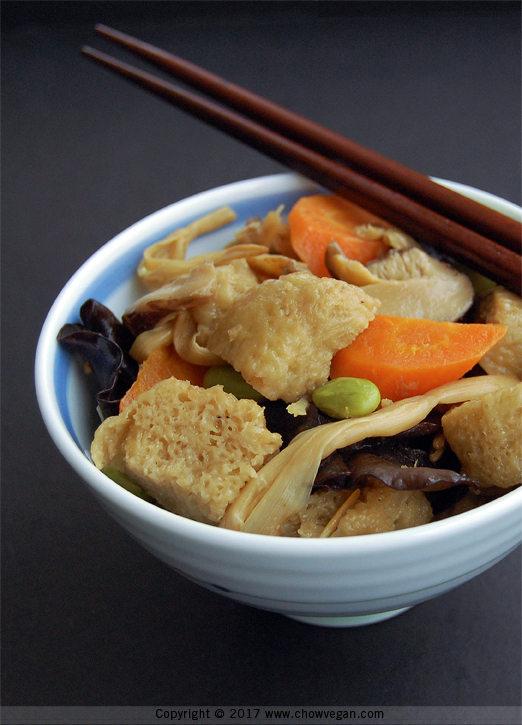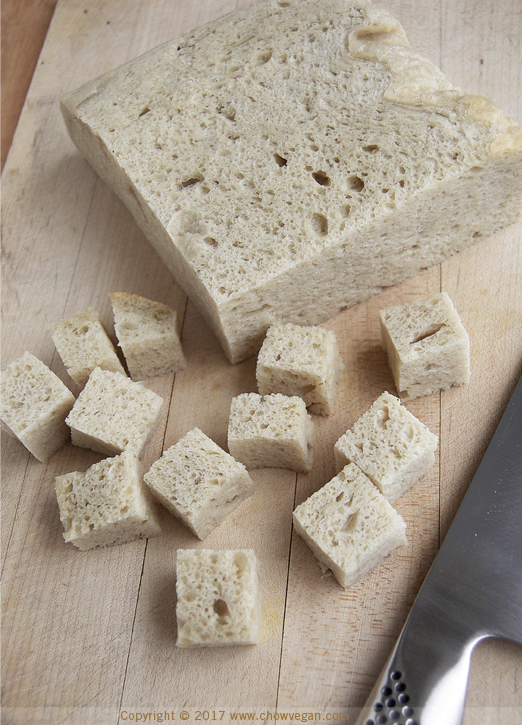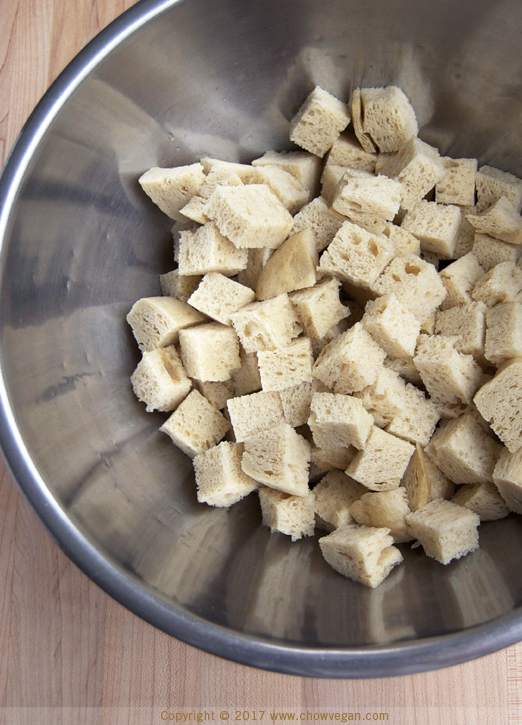
In the west, it’s all about seitan. In Chinese vegetarian cooking, there’s other types of wheat meat, one being kao fu (also known as kau fu) – a classic Shanghai wheat gluten dish typically served at dim sum or as a cold appetizer.
Made from just wheat gluten and water, kao fu is first leavened and then baked or steamed, resulting in a spongy texture with lots of air pockets. The mouth feel is light and airy with a soft chewiness. So delicate and tender compared to seitan’s much denser texture. Like a sponge, it’s perfect for soaking up and absorbing flavors especially when braised.

Usually found in the refrigerated section at the Asian supermarket as cubes or as one big chunk. Often labeled as “Wheat Gluten” or “Wheat Dough”, it’s relatively inexpensive at a couple of bucks for 10 ounces. Out of the package, kao fu looks suspiciously like a big ol’ slice of bread, see above.

Looks like a bowl of diced bread cubes, no? While cutting up the kao fu, it even feels like spongey bread too but wet instead of dry. Traditionally, the wheat gluten is deep fried before stir-frying, but I skipped that part and went with a light pan fry.
Once cooked, it’s very juicy having absorbed all of the water and flavor. I like to serve the kao fu as a meal with rice and a side vegetable instead of an appetizer.
Kao Fu
Serves 4 as part of a meal
10-ounce package fresh wheat gluten, cut into 3/4-inch cubes
4 dried Chinese shiitake mushrooms
1/2 ounce dried lily bulbs
1/2 ounce dried black wood ear fungus
1 medium carrot, roll cut
1/3 cup shelled edamame
2-3 pieces of star anise
1/2-inch piece of fresh ginger, minced
3 tablespoons soy sauce
2 tablespoons rice wine
1 tablespoon brown sugar
3 cups water
1 tablespoon vegetable oil
Put the dried mushrooms, dried wood ear fungus and dried lily bulbs into separate bowls, cover each with cold water. Soak for about an hour or so until soften. Drain and rinse clean. Cut off the mushroom stems and slice. Trim off any hard spots on the wood ear and pinch off the hard end of the lily bulbs.
For the sauce, combine the soy sauce, rice wine and sugar in a small bowl and set aside.
Heat the wok until hot. Swirl in the oil and add the ginger, stir fry until fragrant. Add the wheat gluten to lightly brown, if it starts sticking to the wok, add a bit of water. Next, add the mushrooms, lily bulbs, wood ear, carrot, and edamame, stir fry for about one minute.
Add the sauce mixture, star anise and water. Stir well and bring to a boil. Cover and reduce the heat to low and let simmer for about an hour until most of the liquid has been absorbed. Stir occasionally to prevent sticking. Serve hot, at room temperature or chilled.
Related Posts
Asian-styled Seitan and Vegetable Stew
Chinese Tomato Beef with Jackfruit
Cantonese-style Curry
Wow!
I had never heard of it. It looks so much nicer than the chewy consistency of seitan.
Thank you for sharing!
It is a nice change of pace from density of seitan. :-)
Kao fu is new to me.When I first saw the photo I thought of the dried tofu I used to buy and re-hydrate. It looked exactly the same! It was spongy and weird but oddly pleasant to eat. I haven’t seen it in years. Have you had dried tofu, and is it similar to kao fu?
That’s exactly the texture – spongy, juicy, kinda weird but still good. :-) The only dried tofu I’ve used is the yuba sticks. But there’s so many tofu products at the Asian supermarket that there could well be a similar product.
Not yuba. The dried tofu looked like a stack of sponges — the shape of tofu but about 1/2″ thick. I’m going to look for some next time I’m in an Asian grocery.
I thought I’d heard it all when it came to vegan proteins, but this is the first I’ve come across the term ” kao fu.” It makes a lot of sense now, since I’m certain I’ve eaten this before but couldn’t quite put my finger on it. Thank you for connecting the dots! Now I have a whole lot more research to do… I hope I can find some around here to play with too.
Hopefully you can find it, I would love to see what you would do with the wheat gluten.
Hi! I used to eat kau fu in Taiwan, where it was called “wheat bran”. Just successfully made it at home with 2.5c of wheat gluten flour, a scant teaspoon yeast, 1 t kosher salt, and spoon mixed with enough water to make a smooth softball size dough. Didn’t proof the yeast or use warm water, just cold tap water, didn’t knead either. Rose, covered, 2h at cool room temperature, gently kneaded a few seconds to redistribute yeast, covered and refrigerated overnight. Steamed in a metal colander over a pot of boiling water for 45 minutes. Perfect, spongey wheat bran. Hope you try this if access to kao fu is limited.
Whoa! I’ve never heard of Kao Fu, but it sounds and looks really good. I’ll have to look for it at our Chinese market :)
If you find it, give it a try. It’s usually in the refrigerated section but could also be frozen. And apparently also dried.
Is this the kind of stuff you get dried in packets, sometimes in the shape of flowers, sometimes coloured to? And you drop it in soup and it expands? if so, I have met kao fu before, but I didn’t know that that was its name. It definitely had the same bready texture though. I haven’t seen it fresh anywhere yet, but next time I do, it’s going right in my basket.
It could be, I know there’s many forms of wheat gluten. From your description, the dried sounds way more fun with the expanding in the soup and all. :-) I think I may have tried it in Chinese brands of noodles in a cup. Where you dump the packet of dried veggies and strips of gluten into the cup of dried noodles and add hot water.